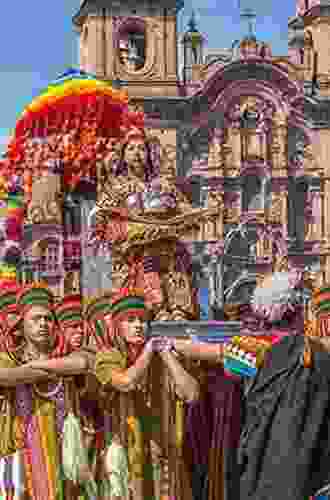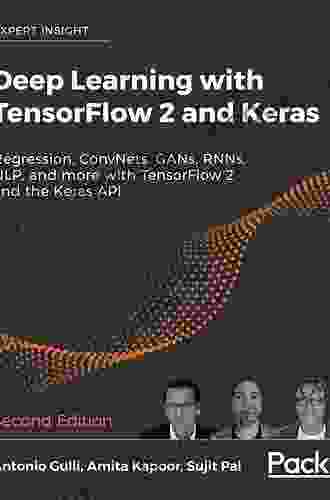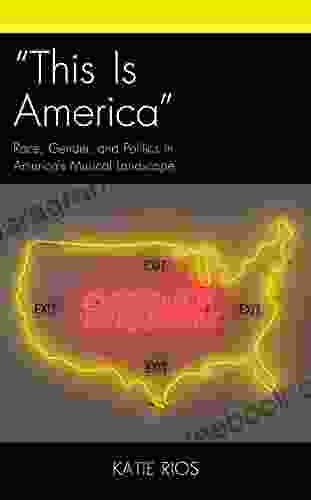A Comprehensive Exploration of Regression, ConvNets, GANs, RNNs, and NLP with TensorFlow and Keras API

TensorFlow and Keras API are powerful tools for machine learning and deep learning applications. TensorFlow, an open-source machine learning library, provides a comprehensive set of tools for creating and deploying machine learning models. Keras, a high-level neural networks API, simplifies the development of neural network models by providing a user-friendly interface.
In this article, we will delve into the capabilities of TensorFlow and Keras API for various machine learning and deep learning tasks, including:
4.5 out of 5
| Language | : | English |
| File size | : | 30297 KB |
| Text-to-Speech | : | Enabled |
| Screen Reader | : | Supported |
| Enhanced typesetting | : | Enabled |
| Print length | : | 648 pages |
- Regression: Predicting continuous numerical values
- Convolutional Neural Networks (ConvNets): Image and object recognition
- Generative Adversarial Networks (GANs): Generating new data
- Recurrent Neural Networks (RNNs): Processing sequential data
- Natural Language Processing (NLP): Understanding and generating human language
1. Regression with TensorFlow and Keras API
Regression is a machine learning technique used to predict continuous numerical values based on a set of input features. TensorFlow and Keras API provide several methods for regression tasks, including:
- Linear Regression: A simple regression model that models a linear relationship between input features and the target value.
- Polynomial Regression: A more complex regression model that models a polynomial relationship between input features and the target value.
- Decision Tree Regression: A tree-based regression model that divides the input feature space into smaller regions to make predictions.
- Neural Network Regression: A deep learning regression model that uses artificial neural networks to model the relationship between input features and the target value.
Code Example for Linear Regression using TensorFlow and Keras API
import tensorflow as tf from keras.layers import Dense from keras.models import Sequential # Create a simple linear regression model model = Sequential() model.add(Dense(units=1, input_dim=1)) # Compile the model model.compile(optimizer='adam', loss='mean_squared_error') # Train the model model.fit(x=x_train, y=y_train, epochs=100) # Evaluate the model model.evaluate(x=x_test, y=y_test)2. Convolutional Neural Networks (ConvNets) with TensorFlow and Keras API
Convolutional Neural Networks (ConvNets) are specialized deep learning models designed for image and object recognition tasks. ConvNets use convolutional layers to extract features from images and identify patterns.
TensorFlow and Keras API provide several pre-built ConvNet architectures, including:
- VGG16: A deep ConvNet architecture developed by the Visual Geometry Group at Oxford University.
- ResNet: A residual network architecture that addresses the vanishing gradient problem in deep neural networks.
- Inception: A deep ConvNet architecture that uses multiple parallel convolutional layers.
- MobileNet: A lightweight ConvNet architecture designed for mobile devices.
Code Example for Image Classification using VGG16 with TensorFlow and Keras API
import tensorflow as tf from keras.applications.vgg16 import VGG16 from keras.preprocessing.image import load_img from keras.preprocessing.image import img_to_array from keras.applications.vgg16 import preprocess_input, decode_predictions # Load the pre-trained VGG16 model model = VGG16() # Load the image to be classified image = load_img('image.jpg', target_size=(224, 224)) # Convert the image to an array image = img_to_array(image) # Preprocess the image image = preprocess_input(image) # Expand the image dimension image = np.expand_dims(image, axis=0) # Classify the image predictions = model.predict(image) # Decode the predictions decoded_predictions = decode_predictions(predictions, top=5)[0] # Print the top 5 predictions for identifier, name, likelihood in decoded_predictions: print(f'Predicted: {name}, Likelihood: {likelihood}')3. Generative Adversarial Networks (GANs) with TensorFlow and Keras API
Generative Adversarial Networks (GANs) are deep learning models that can generate new data that is similar to the training data. GANs consist of two networks: a generator network and a discriminator network.
TensorFlow and Keras API provide several resources for building and training GANs, including:
- GANs tutorial: A step-by-step guide to building and training GANs.
- Pre-trained GAN models: A collection of pre-trained GAN models for various tasks.
- GAN-related datasets: A collection of datasets for training and evaluating GANs.
Code Example for Generating Images using GANs with TensorFlow and Keras API
import tensorflow as tf from tensorflow.keras import layers # Define the generator network generator = tf.keras.Sequential([ layers.Dense(7*7*256, use_bias=False, input_shape=(100,)),layers.BatchNormalization(),layers.LeakyReLU(),layers.Reshape((7, 7, 256)),layers.Conv2DTranspose(128, (5, 5),strides=(1, 1),padding='same', use_bias=False),layers.BatchNormalization(),layers.LeakyReLU(),layers.Conv2DTranspose(64, (5, 5),strides=(2, 2),padding='same', use_bias=False),layers.BatchNormalization(),layers.LeakyReLU(),layers.Conv2DTranspose(1, (5, 5),strides=(2, 2),padding='same', use_bias=False, activation='tanh') ]) # Define the discriminator network discriminator = tf.keras.Sequential([ layers.Conv2D(64, (5, 5),strides=(2, 2),padding='same'),layers.LeakyReLU(),layers.Dropout(0.3),layers.Conv2D(128, (5, 5),strides=(2, 2),padding='same'),layers.LeakyReLU(),layers.Dropout(0.3),layers.Flatten(),layers.Dense(1) ]) # Train the GAN gan = tf.keras.models.Sequential([generator, discriminator]) discriminator.compile(loss='binary_crossentropy', optimizer=tf.keras.optimizers.Adam(learning_rate=0.0002, beta_1=0.5),metrics=['accuracy']) gan.compile(loss='binary_crossentropy', optimizer=tf.keras.optimizers.Adam(learning_rate=0.0002, beta_1=0.5)) # Generate sample images noise = tf.random.normal(shape=(100,)) generated_images = generator(noise)4. Recurrent Neural Networks (RNNs) with TensorFlow and Keras API
Recurrent Neural Networks (RNNs) are deep learning models designed to process sequential data, such as time series or text. RNNs use hidden states to remember information from previous inputs.
TensorFlow and Keras API provide several types of RNNs, including:
- SimpleRNN: A basic RNN architecture that uses a single hidden state.
- LSTM: A more complex RNN architecture that uses long short-term memory (LSTM) cells to remember information over longer periods of time.
- GRU: A gated recurrent unit (GRU) architecture that is similar to LSTM but uses a simpler gating mechanism.
Code Example for Text Classification using RNNs with TensorFlow and Keras API
python import tensorflow as tf from keras.preprocessing.text import Tokenizer from keras.preprocessing.sequence import pad_sequences from keras.models import Sequential from keras.layers import Embedding, LSTM, Dense
# Load the text data texts = ['text_1', 'text_2', 'text_3', 'text_4', 'text_5']
# Tokenize the text data tokenizer = Tokenizer(num_words=1000) tokenizer.fit_on_texts(texts) sequences = tokenizer.texts_to_sequences(texts)
# Pad the sequences to the same length padded_sequences = pad_sequences(sequences, maxlen=100)
# Create the RNN model model = Sequential() model.add(Embedding(1000, 1
4.5 out of 5
| Language | : | English |
| File size | : | 30297 KB |
| Text-to-Speech | : | Enabled |
| Screen Reader | : | Supported |
| Enhanced typesetting | : | Enabled |
| Print length | : | 648 pages |
Do you want to contribute by writing guest posts on this blog?
Please contact us and send us a resume of previous articles that you have written.
 Novel
Novel Page
Page Text
Text Story
Story Newspaper
Newspaper Paragraph
Paragraph Sentence
Sentence Shelf
Shelf Glossary
Glossary Bibliography
Bibliography Preface
Preface Manuscript
Manuscript Scroll
Scroll Tome
Tome Classics
Classics Library card
Library card Biography
Biography Memoir
Memoir Dictionary
Dictionary Narrator
Narrator Character
Character Librarian
Librarian Borrowing
Borrowing Archives
Archives Study
Study Research
Research Scholarly
Scholarly Lending
Lending Reserve
Reserve Journals
Journals Reading Room
Reading Room Rare Books
Rare Books Special Collections
Special Collections Interlibrary
Interlibrary Literacy
Literacy Study Group
Study Group Thesis
Thesis Dissertation
Dissertation Awards
Awards Reading List
Reading List Lynn Marie Lusch
Lynn Marie Lusch Patrick Lose
Patrick Lose Jeffrey D Simon
Jeffrey D Simon Gianluca Antonelli
Gianluca Antonelli Jeffrey Manber
Jeffrey Manber Deborah Edmisten
Deborah Edmisten Mann Robinson
Mann Robinson Paul Scott
Paul Scott Patrick Ejeke
Patrick Ejeke Stephen J King
Stephen J King Norton Paley
Norton Paley Paul Hellyer
Paul Hellyer Bryan Oliver
Bryan Oliver Carrie Herzner
Carrie Herzner Matthew O Thomas
Matthew O Thomas Sarah Boulard
Sarah Boulard Gerhard X Ritter
Gerhard X Ritter Edythe J Greene
Edythe J Greene Ina Koys
Ina Koys Will Eisner
Will Eisner
Light bulbAdvertise smarter! Our strategic ad space ensures maximum exposure. Reserve your spot today!

 Jonathan FranzenHow to Line Dance on a Hoverboard: A Comprehensive Guide to Mastering the...
Jonathan FranzenHow to Line Dance on a Hoverboard: A Comprehensive Guide to Mastering the... Harry HayesFollow ·14.4k
Harry HayesFollow ·14.4k Art MitchellFollow ·4k
Art MitchellFollow ·4k Thomas HardyFollow ·10k
Thomas HardyFollow ·10k Bradley DixonFollow ·10.1k
Bradley DixonFollow ·10.1k Mario SimmonsFollow ·17.9k
Mario SimmonsFollow ·17.9k Arthur MasonFollow ·8.8k
Arthur MasonFollow ·8.8k Rick NelsonFollow ·4.9k
Rick NelsonFollow ·4.9k Grant HayesFollow ·19.6k
Grant HayesFollow ·19.6k

 Ricky Bell
Ricky BellThe Marriage: An Absolutely Jaw-Dropping Psychological...
In the realm of...

 Ray Blair
Ray BlairDiscover the Enchanting Charm of Budapest and Its...
Nestled in the heart of...

 Tyrone Powell
Tyrone PowellHuddle: How Women Unlock Their Collective Power
Huddle is a global movement that empowers...

 Grayson Bell
Grayson BellThe Coin Story of the Holocaust: A Symbol of Hope and...
In the depths of the...

 Virginia Woolf
Virginia WoolfFolklore Performance and Identity in Cuzco, Peru: A...
Nestled amidst...

 Dylan Mitchell
Dylan MitchellThe Enduring Love Story of Héloïse and Abélard: A Tale of...
An Intellectual Passion In the heart of...
4.5 out of 5
| Language | : | English |
| File size | : | 30297 KB |
| Text-to-Speech | : | Enabled |
| Screen Reader | : | Supported |
| Enhanced typesetting | : | Enabled |
| Print length | : | 648 pages |










